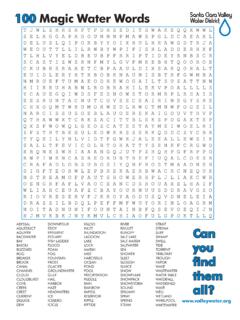Transcription of WASTEWATER TREATMENT - The Water Project
1 9-12 WASTEWATER TREATMENT OBJECTIVESThe student will do the WASTEWATER and list components the function of a wastewatertreatment a WASTEWATER TREATMENT model and use itto clean some primary and secondary WASTEWATER TREATMENT INFORMATIONW astewater is not just sewage. All the Water used in the home that goes down the drains or into thesewage collection system is WASTEWATER . This includes Water from baths, showers, sinks,dishwashers, washing machines, and toilets. Small businesses and industries often contribute largeamounts of WASTEWATER to sewage collection systems; others operate their own WASTEWATER treatmentsystems. In combined municipal sewage systems, Water from storm drains is also added to themunicipal WASTEWATER stream. The average American contributes 265-568 liters (66 to 192 gallons)of WASTEWATER each day.
2 WASTEWATER is about 99 percent Water by weight and is generally referredto as influent as it enters the WASTEWATER TREATMENT facility. Domestic WASTEWATER is wastewaterthat comes primarily from individuals, and does not generally include industrial or WASTEWATER TREATMENT plants, this flow is treated before it is allowed to be returned to theenvironment, lakes, or streams. There are no holidays for WASTEWATER TREATMENT , and most plantsoperate 24 hours per day every day of the week. WASTEWATER TREATMENT plants operate at a criticalpoint of the Water cycle, helping nature defend Water from excessive pollution. Most treatmentplants have primary TREATMENT (physical removal of floatable and settleable solids) and secondarytreatment (the biological removal of dissolved solids).
3 SUBJECT:Science (Physical Science, Physics)TIME:2-3 class periodsMATERIALS:student sheetswriting materialsPrimary TREATMENT to remove large objects, such as stones or sticks, that could plug lines or block tank chamber- slows down the flow to allow grit to fall tank (settling tank or clarifier)- settleable solids settle out and are pumped away, while oils float to the top and are skimmed offSecondary TREATMENT typically utilizes biological TREATMENT processes, in which microorganismsconvert nonsettleable solids to settleable solids. Sedimentation typically follows, allowing thesettleable solids to settle out. Three options Sludge- The most common option uses microorganisms in the TREATMENT processto break down organic material with aeration and agitation, then allows solids to settle out.
4 Bacteria-containing activated sludge is continually recirculated back to the aeration basinto increase the rate of organic Filters- These are beds of coarse media (often stones or plastic) 3-10 ft. deep. WASTEWATER is sprayed into the air (aeration), then allowed to trickle through the media. Microorganisms, attached to and growing on the media, break down organic material in thewastewater. Trickling filters drain at the bottom; the WASTEWATER is collected and then undergoes These are slow, cheap, and relatively inefficient, but can be used for various typesof WASTEWATER . They rely on the interaction of sunlight, algae, microorganisms, and oxygen(sometimes aerated).After primary and secondary TREATMENT , municipal WASTEWATER is usually disinfected using chlorine(or other disinfecting compounds, or occasionally ozone or ultraviolet light).
5 An increasing numberof WASTEWATER facilities also employ tertiary TREATMENT , often using advanced TREATMENT methods. Tertiary TREATMENT may include processes to remove nutrients such as nitrogen and phosphorus, andcarbon adsorption to remove chemicals. These processes can be physical, biological, or solids (sludge) from primary TREATMENT and secondary TREATMENT settling tanks are givenfurther TREATMENT and undergo several options for disposal. (See Sludge TREATMENT and DisposalMethods on page 2-87 & 2-114 thru 2-115.)Termsactivated sludge: sludge particles produced by the growth of microorganisms in aerated tanks as apart of the activated sludge process to treat wastewateraeration: exposing to circulating air; adds oxygen to the WASTEWATER and allows other gases trappedin the WASTEWATER to escape (the first step in secondary TREATMENT via activated sludge process)biochemical oxygen demand (BOD): a laboratory measurement of WASTEWATER that is one of the main indicators of the quantity of pollutants present; a parameter used to measure the amountof oxygen that will be consumed by microorganisms during the biological reaction of oxygenwith organic materialbiosolids: sludge that is intended for beneficial use.
6 Biosolids must meet certain government-specified criteria depending on its use ( , fertilizer or soil amendment).decomposition: the process of breaking down into constituent parts or elementsdomestic WASTEWATER : WASTEWATER that comes primarily from individuals, and does not generally include industrial or agricultural wastewatereffluent: treated WASTEWATER , flowing from a lagoon, tank, TREATMENT process, or TREATMENT plantgrit chamber: a chamber or tank used in primary TREATMENT where WASTEWATER slows down and heavy, large solids (grit) settle out and are removedinfluent: WASTEWATER flowing into a TREATMENT plantlagoons (oxidation ponds or stabilization ponds): a WASTEWATER TREATMENT method that uses pondsto treat WASTEWATER . Algae grow within the lagoons and utilize sunlight to produce oxygen,which is in turn used by microorganisms in the lagoon to break down organic material in thewastewater.
7 WASTEWATER solids settle in the lagoon, resulting in effluent that is relatively welltreated, although it does contain : of or relating to a municipality (city, town, etc.). Municipal WASTEWATER is primarily domestic TREATMENT : the first stage of WASTEWATER TREATMENT that removes settleable or floating solidsonly; generally removes 40% of the suspended solids and 30-40% of the BOD in the wastewatersecondary TREATMENT : a type of WASTEWATER TREATMENT used to convert dissolved and suspended pollutants into a form that can be removed, producing a relatively highly treated effluent. Secondary TREATMENT normally utilizes biological TREATMENT processes (activated sludge, trickling filters, etc.) followed by settling tanks and will remove approximately 85% of theBOD and TSS in WASTEWATER . Secondary TREATMENT for municipal WASTEWATER is the minimumlevel of TREATMENT required by the Clean Water : the process used in both primary and secondary WASTEWATER TREATMENT , that takes place when gravity pulls particles to the bottom of a tank (also called settling).
8 Settling tank (sedimentation tank or clarifier): a vessel in which solids settle out of Water by gravity during WASTEWATER or drinking Water TREATMENT : any solid, semisolid, or liquid waste that settles to the bottom of sedimentation tanks (in WASTEWATER TREATMENT plants or drinking Water TREATMENT plants) or septic tankstertiary TREATMENT : any level of TREATMENT beyond secondary TREATMENT , which could include filtration, nutrient removal (removal of nitrogen and phosphorus) and removal of toxic chemicals or metals; also called advanced TREATMENT when nutrient removal is includedtotal suspended solids (TSS): a laboratory measurement of the quantity of suspended solids presentin WASTEWATER that is one of the main indicators of the quantity of pollutants presenttrickling filter process: a biological TREATMENT process that uses coarse media (usually rock or plastic) contained in a tank that serves as a surface on which microbiological growth occurs.
9 WASTEWATER trickles over the media and microorganisms remove the pollutants (BOD and TSS). Trickling filters are followed by settling tanks to remove microorganisms that wash off or pass through the trickling filter : the cloudy or muddy appearance of a naturally clear liquid caused by the suspension of particulate matterwastewater: Water that has been used for domestic or industrial the transparencies of teacher Sheets. Copy Student the processes involved at a typical municipal WASTEWATER TREATMENT typical municipal WASTEWATER collection systems. discussion to any relevant local or national WASTEWATER students complete Student (Optional): Have students research pertinent local or national WASTEWATER issues andwrite a paper on their issue of students determine which types of TREATMENT (primary, secondary, tertiary) and specific processes are used at the local municipal WASTEWATER TREATMENT students discuss the plant s efficiency (with respect to various contaminants)with a plant operator.
10 Learn about any pretreatment operations conducted for industrial the local municipal WASTEWATER TREATMENT plant, or invite a speaker from theplant to talk to the a video or slides of various types of WASTEWATER TREATMENT which types of municipal TREATMENT processes are used in industrial WASTEWATER TREATMENT processes. Discuss which processes are used for particular industries and Geographic Society Teachers handbook , Geography: Reflections on Water , Nov. Projects on File, Cleaning Dirty Water , , The Diagram Environment Federation, Clean Water for Today: What is WASTEWATER TREATMENT ? 1-800-444-2933 (Fax Reply Service)Student SheetStudent Sheet





